IDEX Online Research: March Diamond Prices Continue to Rise Sharply
April 03, 08
Global polished diamond prices continued to march upward at an increasing rate in March. On a year-over-year basis, polished diamond prices surged by 8.6 percent, according to the IDEX Online Global Polished Diamond Price Index. On a month-over-month basis – March 2008 vs. February 2008 – polished diamond prices increased sharply by 2.0 percent. Both of these price increases are the largest since the IDEX Online Global Polished Price Index was initiated in 2004, and they are greater than the record price gains last month.
The sharp price increases in polished diamonds were driven by three-carat diamonds and larger. This is a change from prior months, when prices on two-carat and above size stones drove the IDEX Online Price Index higher. While prices for one-half to two-carat stones increased more modestly than the larger stones, it is important to note that all key diamond sizes posted a price increase, year-over-year, in March.
Furthermore, in March, the price of five-carat stones rose at a more modest rate than four-carat stones. The more modest price increase of five-carat stones correlates to the retail market. Most jewelers have noted a slowdown in demand for their most expensive goods. Shoppers are either opting for smaller stones, or they are re-working family jewelry. Either way, the most expensive stones are apparently not selling at the same pace at retail as they were a year ago.
There appear to be five key factors that are driving diamond prices sharply higher: 1) solid demand from most markets, except the U.S. and Japan; 2) rising costs throughout the diamond pipeline; 3) a weakening U.S. dollar, the international currency for the diamond market; 4) a global rise in the price of virtually all commodities which has spilled over into the diamond market; and 5) stock market volatility, the last of which has caused some traders to move their wealth into diamonds, precious metals, and other assets that may hold their value, until the financial markets recover.
The big question is this: will these diamond price increases hold at retail, or will merchants negotiate them down?
Even though the U.S. is in a recession, demand from other regions of the world is expected to push diamond prices higher during 2008. As long as the demand for diamonds and diamond jewelry remains strong, especially in emerging markets, prices are expected rise. Further, since rough diamond prices have been rising faster than polished diamond prices, there is ongoing pressure to pass along those price increases.
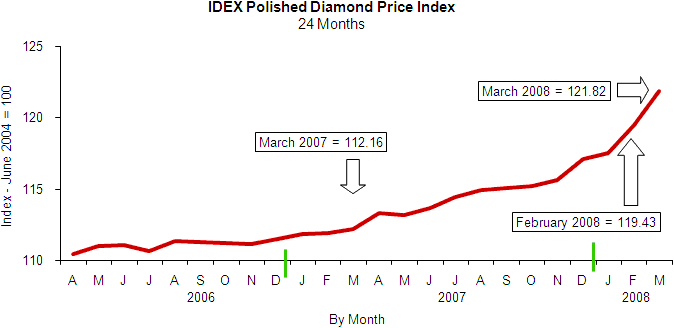 Source: IDEX Online Research |
| |
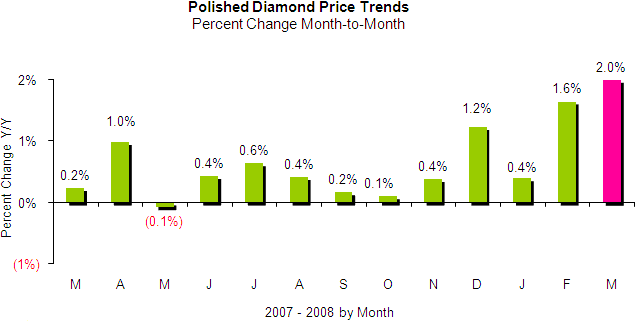 Source: IDEX Online Research |
March 2008 versus March 2007: +8.6 percent 
We don’t think March’s diamond price inflation rate is sustainable, even though rough diamond prices are rising at a significant pace. However, most other commodities have risen sharply in price over the past several years. Diamonds are late to the “inflation party”, but perhaps their time has come. As we have said many times, the diamond industry remains too fragmented for anyone – or any group – to hold pricing power similar to the tight-knit community of rough diamond suppliers. At the retail level, many merchants have announced that they are planning to raise their prices during the first half of 2008. The IDEX Online Polished Diamond Price Index stood at 121.82 in March 2008 versus 112.16 in March a year ago.
On a year-over-year basis, polished diamond prices have shown larger and larger gains each month over the past year or so. The graph below summarizes year-over-year monthly polished diamond prices for the global market since the beginning of 2007.
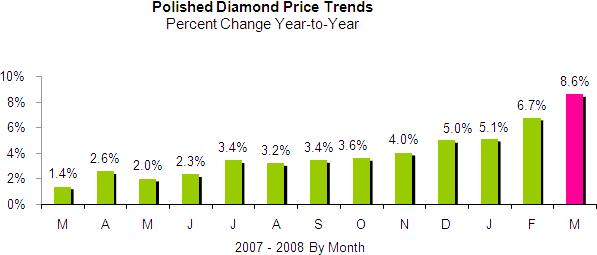 Source: IDEX Online Research |
Polished Diamond Prices Were Volatile in March
Polished prices gyrated during March, on a year-over-year basis. Early in the month, they were steady. There was a sharp spike mid-month, followed by another period of relative stability. Prices finished the month on a high note. The mid-month price spike was caused by a confluence of factors: 1) the U.S. dollar dropped in value; 2) stock markets in the U.S., Israel, and India sold off; and 3) an anticipated rough diamond price increase prior to the late month DTC sight. The following graph illustrates the average price of polished diamonds on a day-by-day basis in March 2008.
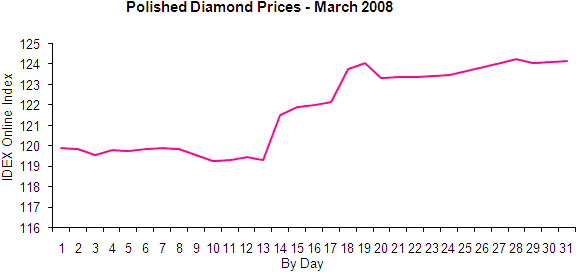 Source: IDEX Online Research |
Diamond Demand Remains Strong for Large Sizes
What’s selling at retail? Merchants report that larger, better quality diamonds are in demand, and the prices of these spectacular gemstones reflects strong retail demand. However, it is interesting to note that four-carat stones showed the largest gains in March on a month-to-month comparison; three- and five-carat stones showed smaller gains. In fact, five-carat stone prices showed the smallest month-to-month price increase of all the sizes on our graph (below). In a recessionary environment, this is to be expected: most consumers at all levels appear to be “shopping down.” Rather than purchase a five-carat stone as a second diamond for the same wife, some shoppers are opting for slightly smaller, though still flashy, three- and four-carat stones.
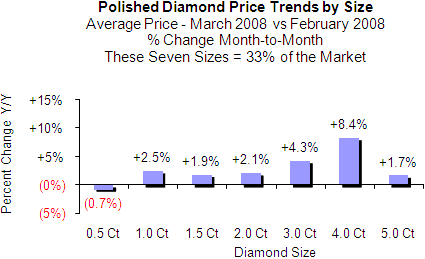 Source: IDEX Online Research |
On a year-to-year comparison, polished diamond prices showed a greater bias: prices for large stones in the three-to-five carat range rose much more sharply while prices of stones two-carat and smaller posted only a small, but notable, gain. Did four-carat polished diamonds really rise by 59 percent year-over-year? Ask any diamantaire who deals in large high quality stones: they will confirm that prices are spiking daily.
Following February, March is the second month when all key diamond sizes – one-half carat through five-carat stones – showed a price increase on a year-over-year basis. The price increase for smaller stones in the one-half carat size range was modest, but it was up.
The graph below summarizes polished diamond prices by key sizes on a year-over-year basis: March 2008 versus March 2007. These seven sizes represent about one-third of the market, by aggregate value.
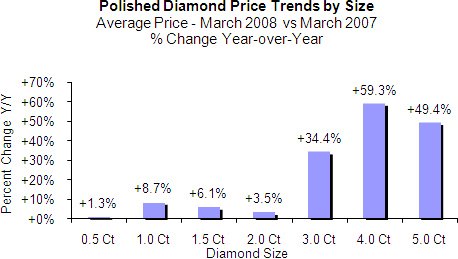 Source: IDEX Online Research |
Forecast: Polished Diamond Prices Higher, With No End in Sight
Global economic growth is expected to decelerate modestly during 2008, particularly among two of the world’s larger economies. In the U.S., economists are predicting a short, mild recession, perhaps in the first and second quarter. Consumers have been in a mental recession, and have cut back on their discretionary spending.
Further, economic woes in the U.S. market will spill over into the global diamond and jewelry markets. The U.S. market historically has about half of all the world’s diamonds and diamond jewelry by value. High growth economies – such as China and India – are reining in growth in an effort to avoid inflation. As a result, jewelry and diamond demand during 2008 is expected to moderate, though gains will likely be solid.
Because rough diamond prices are rising at a pace faster than polished diamond prices, there is much pressure on cutters and polishers to raise their prices, a trend that is likely to continue. This will keep polished diamond prices from falling, and should provide support, along with baseline consumer demand, to send prices higher, but at a more moderate rate.
The IDEX Online Diamond Price Index
The IDEX Online Diamond Price Index is a real-time index derived from actual asking prices in the global diamond industry. The IDEX Online Diamond Price Index objectively reflects price trends as they happen. The Diamond Index and Diamond Drivers were formulated following comprehensive research and analysis of the IDEX Online inventory database, aggregated since 2001. Research and development were conducted in cooperation with Dr. Avi Wohl, Senior Lecturer of Finance at the faculty of Management, Tel Aviv University, Israel.
Additional information is available from IDEX Online Research at diamondprices[at]idexonline[dot]com.
